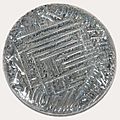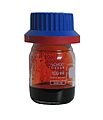Periodic table (metals and non-metals) facts for kids
The periodic table is like a special map for all the known chemical elements in the universe. It helps scientists and students understand how elements are related. Each element is a basic substance that cannot be broken down into simpler parts. Think of elements as the building blocks of everything around us, from the air we breathe to the stars in space.
This amazing table was first created by a Russian scientist named Dmitri Mendeleev in 1869. He noticed that elements had repeating patterns in their properties. He arranged them so that elements with similar behaviors lined up. This made it easier to predict what new elements might be like, even before they were discovered!
Contents
Understanding the Periodic Table
The periodic table organizes elements in a very smart way. Each box on the table represents a different element. Inside each box, you'll usually find:
- The element's atomic number (the number of protons).
- The element's chemical symbol (like H for Hydrogen).
- The element's full name (like Hydrogen).
Rows: Periods
The horizontal rows in the periodic table are called periods. There are seven periods. As you move from left to right across a period, the atomic number of the elements increases by one. Elements in the same period have the same number of electron shells.
Columns: Groups
The vertical columns in the periodic table are called groups or families. There are 18 groups. Elements in the same group often have similar chemical properties. This is because they have the same number of electrons in their outermost shell. For example, elements in Group 1 (like Li and Na) are very reactive metals.
Types of Elements
Elements can be broadly divided into three main types based on their properties: metals, metalloids, and nonmetals. The colors in the table help us see these differences easily.
| Group | 1 | 2 | 3 | 4 | 5 | 6 | 7 | 8 | 9 | 10 | 11 | 12 | 13 | 14 | 15 | 16 | 17 | 18 | ||
| Period | ||||||||||||||||||||
| 1 | 1 H |
2 He |
||||||||||||||||||
| 2 | 3 Li |
4 Be |
5 B |
6 C |
7 N |
8 O |
9 F |
10 Ne |
||||||||||||
| 3 | 11 Na |
12 Mg |
13 Al |
14 Si |
15 P |
16 S |
17 Cl |
18 Ar |
||||||||||||
| 4 | 19 K |
20 Ca |
21 Sc |
22 Ti |
23 V |
24 Cr |
25 Mn |
26 Fe |
27 Co |
28 Ni |
29 Cu |
30 Zn |
31 Ga |
32 Ge |
33 As |
34 Se |
35 Br |
36 Kr |
||
| 5 | 37 Rb |
38 Sr |
39 Y |
40 Zr |
41 Nb |
42 Mo |
43 Tc |
44 Ru |
45 Rh |
46 Pd |
47 Ag |
48 Cd |
49 In |
50 Sn |
51 Sb |
52 Te |
53 I |
54 Xe |
||
| 6 | 55 Cs |
56 Ba |
* |
71 Lu |
72 Hf |
73 Ta |
74 W |
75 Re |
76 Os |
77 Ir |
78 Pt |
79 Au |
80 Hg |
81 Tl |
82 Pb |
83 Bi |
84 Po |
85 At |
86 Rn |
|
| 7 | 87 Fr |
88 Ra |
* * |
103 Lr |
104 Rf |
105 Db |
106 Sg |
107 Bh |
108 Hs |
109 Mt |
110 Ds |
111 Uuu |
112 Uub |
113 Uut |
114 Uuq |
115 Uup |
116 Uuh |
117 Uus |
118 Uuo |
|
| * Lanthanides | 57 La |
58 Ce |
59 Pr |
60 Nd |
61 Pm |
62 Sm |
63 Eu |
64 Gd |
65 Tb |
66 Dy |
67 Ho |
68 Er |
69 Tm |
70 Yb |
||||||
| ** Actinides | 89 Ac |
90 Th |
91 Pa |
92 U |
93 Np |
94 Pu |
95 Am |
96 Cm |
97 Bk |
98 Cf |
99 Es |
100 Fm |
101 Md |
102 No |
||||||
| Metals | Metalloids | Nonmetals |
Color Coding for Atomic Numbers
The color of the atomic number tells you about the element's state at Standard Temperature and Pressure (STP). STP is a common set of conditions (like room temperature and normal air pressure) used for experiments.
- Elements with numbers in blue are liquids at STP.
- Those in green are gases at STP.
- Those in black are solid at STP.
- Elements in red are synthetic. This means they are made by humans and do not occur naturally. All synthetic elements are solid at STP.
- Elements in gray have not yet been discovered. Their muted colors suggest what type of element they might be.
Related pages
Images for kids
-
Pure (99.97%+) iron chips, electrolytically refined, accompanied by a high purity (99.9999% = 6N) 1 cm3 cube
-
Tellurium, described by Dmitri Mendeleev as forming a transition between metals and nonmetals
-
25 ml of bromine, a dark red-brown liquid at room temperature




